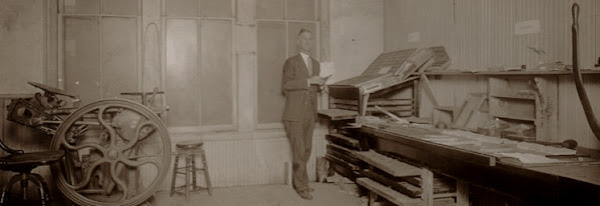
While in generally good if typically dirty condition, the perforator had one serious problem: at one time it sat someplace where water was allowed to get onto the punch assembly. This assembly consists of three main parts besides said punches: the punch holder, the stripper, and the die. The punches are 13/16” long and a little over 1/32" diameter with a small head on one end like a brad. They drop into holes in the punch holder and down through the stripper bar. When the treadle is depressed the punches are pushed down through the stripper bar and into the die which has corresponding holes. Well, when stored at some point the head which carries the punch assembly was adjusted in such a way that the punches were pushed down below the bottom of the stripper. Add water, time, and neglect and presto! Rusted punches, punch carrier, stripper, and die plate. O joy!

Adding a bit to the sorrow is the fact that at some point someone with more physicality than patience tried to loosen the head and get the punches moving. To do this he inserted some kind of crow bar into the assembly and did what one does with a crow bar. While not loosening the punches it did have the affect of snapping the heads off four of the six screws by which the punch holder is attached to the head. His work apparently done, the perforator was left to get older. On the bright side the tables, while needing refinishing, are in good shape and it has both of its original fences with attachments. Also, it is not rusty to the same degree on all the punches.
Having disassembled and restored any number of antique machines in various degrees of decrepitude, I was reasonably certain that I could get it apart and that it could be cleaned and restored to use. The first step was to somehow get the punch assembly off the head and disassemble it. There was little point in cleaning anything else unless this could be accomplished. I sprayed on a liberal dose of PB Blaster “penetrating catalyst” and let it soak. I was prepared for a long process and this was the first step. Over the next three days I kept adding more Blaster and gently pried and tapped. No crow bar. During that time I was able to remove enough of the punches from both ends to get at the two bolts that hold the stripper bar to the bed. The stripper bar is attached to the bed and normally you can remove the entire head with the punches with the stripper bar remaining behind. But of course the punches were rusted to the bar. So in this case when I was finally able to lift off the head the stripper bar came with it.
Now I had access to the bottom of the stripper bar and after a couple more days of soaking I was able to tap the bottom of some of the punches to loosen them and pull them out. Just like pulling teeth, both descriptively and in terms of it being somewhat difficult. Keep in mind that there are literally hundreds of punches. I haven’t counted all of them yet but have got as far as 238. I got enough out finally to bend the stripper bar slightly and come at the screw heads of the last two screws holding the punch holder to the cast iron head using a right-angle screwdriver. More soaking and more tapping. It took a week but finally the last punch came out. Now all the parts needed to be cleaned down to original paint or bare metal. I don't like repainting unless absolutely necessary but I hate rust. I let the punches and some other parts soak overnight in a solution of vinegar and salt to loosen the rust up. Except for heavy rust this allows you to virtually wipe if off. In the process of removing the punches a number of them were bent or broken but I saved about 230 and I’m hoping they will work once clean. Replacements seem to be available from a couple sources and I’ve been in touch to get particulars. If the price is right I’ll replace them all and keep the old ones as spares.
Four screw heads had been broken off in the head and I had to drill out the remaining parts of the screw. I’ll pick up replacements at the hardware store. Cleaning itself was straight forward using WD-40; sandpaper; 3M green pads; a wire brush on a grinder and drill; and lots of paper towels. I’m not afraid to use sandpaper to get heavy rust off, stopping as soon as I get to bare metal. Then it’s the green pads and finally the wire wheel to make it nice. I used one of the old punches to clean out the inside of the hundreds of holes in the punch holder, stripper bar, and die plate. They weren’t that bad, the punches having provided some protection from direct exposure. But this part of the job was very tedious and cleaning the holes in the three parts took 5 hours. I did this in the evening while watching TV.
The main frame has been cleaned and the die plate reinstalled but for one screw that needs to be replaced. Once I get that screw and the others I need everything can be reassembled. At that point we’ll see if actually works. I hope to refinish the wood tables this week at work. More on that and what exactly I’ll be doing with it will wait for another post.



3 comments:
Great piece - i have never seen anything like this! Fantastic restoration project!
That's quite an undertaking, but you make it sound so easy.
I'm constantly amazed by the rust-removing powers of vinegar, but I usually use a lemon juice and vinegar mixture, whereas you used salt and vinegar (mmm, potato chips). Why salt? Or why lemon juice (for the acid, I assume)?
I'm looking forward to seeing what you end up doing with it. Are you going to use a paper with a sticky back or glue?
-Maggie
From what I understand the salt and vinegar act together to create a mild acid. I don't know about the lemon oil though it's acidic by itself of course.
If the metal is left too long in the bath it will start getting eaten. Generally overnight does the trick. When you look at it in the morning it looks like nothing has changed but when you take the parts out and scrub with a green pad the rust just wipes right off.
Heavy rust will stay but is then clearly seen and can be removed with sandpaper, targeting only those areas. The bath would eventually remove it too but then the rest of the surface that doesn't need such drastic treatment would get pitted.
Once all the rust is removed I use a green pad with WD40 to scrub the entire part. This also adds lubricant to the metal. The vinegar solution removes oil from just below the surface and if it is not re-lubricated it will rust again quickly. The WD40 at this stage does not provide permanent replacement but will keep it from rusting until your done working with the part. Once completely clean I wipe a reasonably heavy coat of oil on the part and let it sit overnight before wiping it down a final time.
After the green pad I use a wire brush on a grinder which gets into any nooks and crannies and polishes the metal. If I wanted to go crazy I could use increasingly finer grits of sandpaper and get it to a bright, mirror finish. I'm too pragmatic to get crazy.
Post a Comment